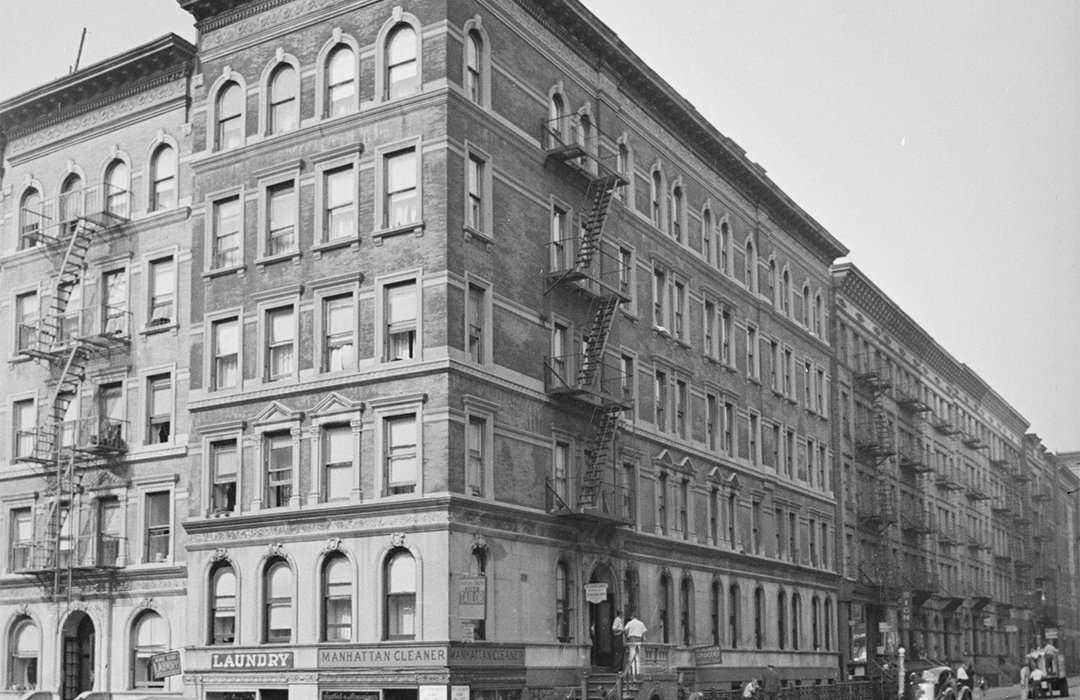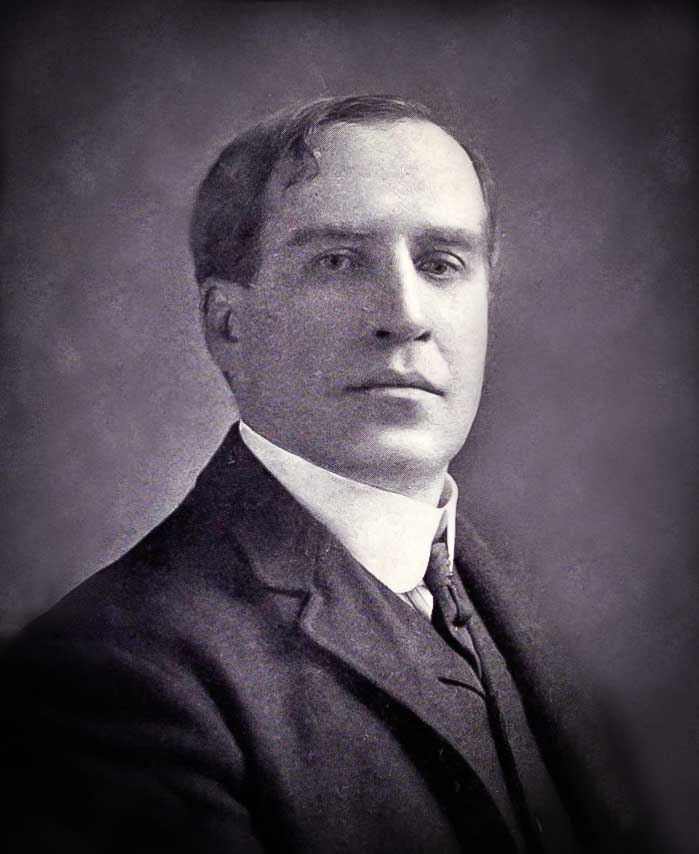
19 Manhattan Ave.
by Tom Miller
Designed by James W. Cole, real estate developer William Rankin erected four five-story apartment buildings at 11 through 19 Manhattan Avenue in 1897. The corner structure was slightly taller than the others because of the stores along the basement or sidewalk level. And because of the stores, the residential entrance was located around the corner at 60 West 101st Street. Above the limestone-clad first floor with its arched openings, the upper four floors were faced in red brick and trimmed in stone. Elements of Cole’s Renaissance Revival design included peaked pediments above certain second-floor windows and an ornate frieze of swirling vines below the bracketed cornice.
The apartments held five rooms and a bath, and tenants enjoyed “steam heat [and] hot water.” The tenants here at the turn of the century paid $33 per month in rent, or about $1,270 in 2025 terms. Among them were Helen Rivers, who advertised herself as the “celebrated Card Reader, Palmist, Clairvoyant,” and Mrs. Frederick C. Bursch, who had been a member of the New York Library Club since 1898.
Bowen Wheeler occupied an apartment at the time. He fell for a shady deal in which he purportedly would make quick (if illegal) money in 1903. In September, he met a man named John Phillips. Phillips explained that he was “a dealer in a gambling house in West Forty-fifth street,” and that he could “put him on to a scheme by which he could beat a faro game,” according to The Sun. John Phillips took Wheeler to the gambling house, where Wheeler lost $1,000 (a significant $36,800 today). The Sun said, “When he thought things over, he decided that he had been swindled.”
Wheeler had Phillips arrested on October 1. But when Assistant District Attorney O’Connor listened to the details, “he didn’t think there were any grounds for a complaint.” Wheeler, he explained, “entered into a scheme to beat an unlawful game.” His case was dismissed.
She crowded into the elevator and began reading one of the letters…
Sarah A. Fletcher, who lived here as early as 1906, was an unmarried businesswoman. Since 1897, she had operated a tenth-floor office on 25th Street and Broadway where she “did a great deal of theatrical typewriting, and was well known in the theatrical circles,” according to The New York Times. On the morning of August 21, 1906, she arrived at the Townsend Building, where she worked with a bundle of business letters she had brought from home. She crowded into the elevator and began reading one of the letters, “apparently unconscious of her surroundings,” according to The Times. After the seventh floor, only Sarah and a small girl remained in the car. The girl had asked the operator, John Brown, to let her off on the eighth floor.
Brown stopped the elevator at the eighth floor and let the girl off. Absorbed in her reading, Sarah Fletcher thought she had arrived at the 10th floor. When Brown started to close the gate, “Miss Fletcher, still reading, started forward.” Brown extended his arm to stop her, but “With a slight show of impatience at being thus interfered with, Miss Fletcher, who was a heavy woman, tried to brush past Brown and partly succeeded. Her weight thrown against his arm caused him to lose his balance and he fell to the left.” In doing so, he “involuntarily pulled the lever over with him, and the car shot up.”
Sarah Fletcher’s feet were still in the car, but she was leaning out. “As the elevator shot up she was thrown to the floor, and, the car still ascending, her head was caught between the edge of the car floor and the top of the doorway.” Sarah’s head was crushed, and she died instantly.
Owen Frawley Kildare’s life could have been plucked from a Horatio Alger pulp novel. Born on the Lower East Side in 1864, Kildare’s father had died three months before he was born, and his mother died shortly afterward. He was taken in by a foster family until he was seven, when, after having suffered severe abuse, he left. A newsboy loaned him five cents to buy newspapers to sell. He survived as a newsboy until the age of 14, when he began making money by boxing. He became known as “the champion of the Park Row newsies.”
One afternoon, a schoolteacher named Marie Rose Deering stopped a fight between Kildare and a drunk named Skinny. “And you are men!” she chastised them, according to Kildare later. Kildare offered to escort her home as protection. Marie Rose discovered that Kildare was illiterate and began tutoring him. After months, he could read and write and took a job as a baggage agent for $8 a week. He saved money until, in 1900, he had enough to ask Marie Rose (whom he called Mamie) to marry him. The date was arranged, but just one week before the wedding, Marie Rose died.
Kildare fell into a deep depression, saying later that he joined the “has beens” on park benches. Then he noticed an advertisement in a newspaper for a prize for the best short love story. He wrote My Mamie Rose on yellow wrapping paper and submitted it to Leita Russell Bogartus, who wrote under the name Leita Russell. His story was a sensation. In 1903, Kildare and Leita were married and moved into an apartment here.
While living here, Kildare wrote The Good of the Wicked, The Widow of the Simple, and My Old Bailiwick. In 1908, Kildare and playwright Walter Hackett adapted My Marie Rose to the stage, calling it Regeneration. Kildare’s part was played by the famous star Arnold Daly. Without Kildare’s knowledge, Daly rewrote parts of his role. When Kildare and Leita attended the opening performance, he was first angered and then despondent about Daly’s interpretation.
His story was a sensation.
In October, Kildare wrote, “I’ve gone through a great depression of health and finances, and there was a time five or six weeks ago that I thought of suicide.” On November 24, 1908, The Sun reported, “Kildare was arrested early yesterday morning in the apartment house in which he lives at 60 West 101st Street.” The article said he had been “committed to Bellevue yesterday for observation as to his sanity.” The New York Times explained, “Mr. Kildare had the present acute attack of asphasia and nervous collapse on Sunday night. He was unable to speak, and soon became unconscious.”
Leita told reporters, “Mr. Kildare is ill because of the failure of ‘The Regeneration,’ which was offered early in the present season…It was not played as Mr. Kildare wrote it.” She said, “It was all we could do to keep him from attacking the actor. He became morose, morbid, and frequently talked of suicide.” Sadly, Kildare was hospitalized at Bellevue Psychiatric Hospital from 1908 until his death in 1911.
William C. Poertner, head of the Poertner Motor Car Company, lived here in January 1909 when he married Helen Howard. Poertner was not only interested in constructing and selling automobiles, but he was also concerned about their safe operation. In May 1914, he suggested that motorcycle officers wear uniforms. (Bicycle and motorcycle cops wore street clothes at the time.) He said that if potential speeders saw “a motor-cycle policeman in uniform, it would act as a check to their speeding instantly.” And in April 1915, as more motor vehicles took to New York City streets, he wrote to Borough President Marks saying that “public parking places for automobiles such as were found in many cities, were needed in Manhattan.”
The building continued to house middle-class tenants until mid-century. In 1952, the concept of the Frederick Douglass Houses was approved by the city. Exactly one decade later, the massive urban renewal project erased 19 Manhattan Avenue and the buildings around it.
Tom Miller is a social historian and blogger at daytoninmanhattan.blogspot.com



